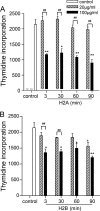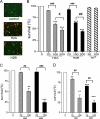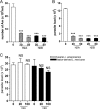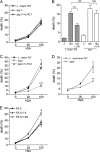Differential microbicidal effects of human histone proteins H2A and H2B on Leishmania promastigotes and amastigotes
- PMID: 21189319
- PMCID: PMC3067510
- DOI: 10.1128/IAI.00658-10
Differential microbicidal effects of human histone proteins H2A and H2B on Leishmania promastigotes and amastigotes
Abstract
Recent studies have shown that histone proteins can act as antimicrobial peptides in host defense against extracellular bacteria, fungi, and Leishmania promastigotes. In this study, we used human recombinant histone proteins to further study their leishmaniacidal effects and the underlying mechanisms. We found that the histones H2A and H2B (but not H1(0)) could directly and efficiently kill promastigotes of Leishmania amazonensis, L. major, L. braziliensis, and L. mexicana in a treatment dose-dependent manner. Scanning electron microscopy revealed surface disruption of histone-treated promastigotes. More importantly, the preexposure of promastigotes to histone proteins markedly decreased the infectivity of promastigotes to murine macrophages (Mφs) in vitro. However, axenic and lesion-derived amastigotes of L. amazonensis and L. mexicana were relatively resistant to histone treatment, which correlated with the low levels of intracellular H2A in treated amastigotes. To understand the mechanisms underlying these differential responses, we investigated the role of promastigote surface molecules in histone-mediated killing. Compared with the corresponding controls, transgenic L. amazonensis promastigotes expressing lower levels of surface gp63 proteins were more susceptible to histone H2A, while L. major and L. mexicana promastigotes with targeted deletion of the lipophosphoglycan 2 (lpg2) gene (but not the lpg1 gene) were more resistant to histone H2A. We discuss the influence of promastigote major surface molecules in the leishmaniacidal effect of histone proteins. This study provides new information on host innate immunity to different developmental stages of Leishmania parasites.
Figures







Similar articles
-
Expression of the major surface glycoprotein of Leishmania, gp63, in wild-type and sinefungin-resistant promastigotes.Eur J Biochem. 1994 Jul 1;223(1):61-8. doi: 10.1111/j.1432-1033.1994.tb18966.x. Eur J Biochem. 1994. PMID: 8033909
-
Leishmania donovani lacking the Golgi GDP-Man transporter LPG2 exhibit attenuated virulence in mammalian hosts.Exp Parasitol. 2009 Jul;122(3):182-91. doi: 10.1016/j.exppara.2009.03.014. Epub 2009 Mar 27. Exp Parasitol. 2009. PMID: 19328787 Free PMC article.
-
The role of surface glycoconjugates in Leishmania midgut attachment examined by competitive binding assays and experimental development in sand flies.Parasitology. 2013 Jul;140(8):1026-32. doi: 10.1017/S0031182013000358. Epub 2013 Apr 23. Parasitology. 2013. PMID: 23611086
-
Promastigote parasites cultured from the lesions of patients with mucosal leishmaniasis are more resistant to oxidative stress than promastigotes from a cutaneous lesion.Free Radic Biol Med. 2018 Dec;129:35-45. doi: 10.1016/j.freeradbiomed.2018.09.005. Epub 2018 Sep 7. Free Radic Biol Med. 2018. PMID: 30196081
-
Targeted gene deletion of Leishmania major genes encoding developmental stage-specific leishmanolysin (GP63).Mol Microbiol. 1998 Feb;27(3):519-30. doi: 10.1046/j.1365-2958.1998.00689.x. Mol Microbiol. 1998. PMID: 9489664
Cited by
-
Neutrophils versus Protozoan Parasites: Plasmodium, Trichomonas, Leishmania, Trypanosoma, and Entameoba.Microorganisms. 2024 Apr 19;12(4):827. doi: 10.3390/microorganisms12040827. Microorganisms. 2024. PMID: 38674770 Free PMC article. Review.
-
Far beyond Phagocytosis: Phagocyte-Derived Extracellular Traps Act Efficiently against Protozoan Parasites In Vitro and In Vivo.Mediators Inflamm. 2016;2016:5898074. doi: 10.1155/2016/5898074. Epub 2016 Jun 30. Mediators Inflamm. 2016. PMID: 27445437 Free PMC article. Review.
-
The site of the bite: Leishmania interaction with macrophages, neutrophils and the extracellular matrix in the dermis.Parasit Vectors. 2016 May 4;9:264. doi: 10.1186/s13071-016-1540-3. Parasit Vectors. 2016. PMID: 27146515 Free PMC article. Review.
-
Leishmania infantum Axenic Amastigotes Induce Human Neutrophil Extracellular Traps and Resist NET-Mediated Killing.Trop Med Infect Dis. 2023 Jun 25;8(7):336. doi: 10.3390/tropicalmed8070336. Trop Med Infect Dis. 2023. PMID: 37505632 Free PMC article.
-
Immunopathogenesis of non-healing American cutaneous leishmaniasis and progressive visceral leishmaniasis.Semin Immunopathol. 2012 Nov;34(6):735-51. doi: 10.1007/s00281-012-0350-8. Epub 2012 Oct 11. Semin Immunopathol. 2012. PMID: 23053396 Free PMC article. Review.
References
-
- Appelberg, R. 2007. Neutrophils and intracellular pathogens: beyond phagocytosis and killing. Trends Microbiol. 15:87-92. - PubMed
-
- Bahr, V., et al. 1993. Expression of lipophosphoglycan, high-molecular weight phosphoglycan and glycoprotein 63 in promastigotes and amastigotes of Leishmania mexicana. Mol. Biochem. Parasitol. 58:107-121. - PubMed
-
- Brinkmann, V., et al. 2004. Neutrophil extracellular traps kill bacteria. Science 303:1532-1535. - PubMed
-
- Chan, D. I., E. J. Prenner, and H. J. Vogel. 2006. Tryptophan- and arginine-rich antimicrobial peptides: structures and mechanisms of action. Biochim. Biophys. Acta 1758:1184-1202. - PubMed
Publication types
MeSH terms
Substances
Grants and funding
LinkOut - more resources
Full Text Sources

